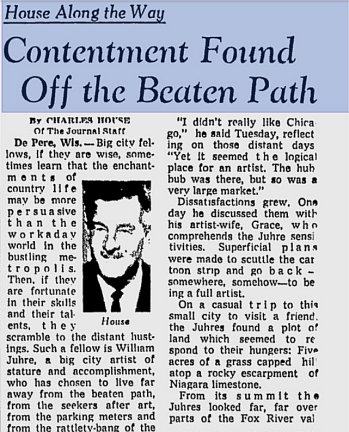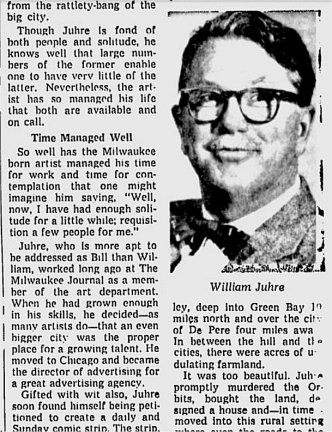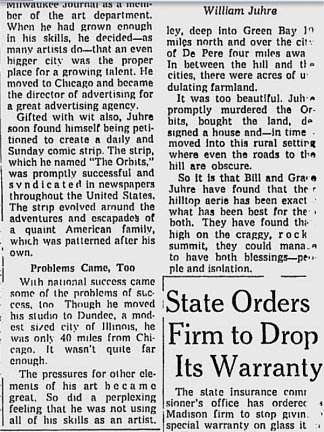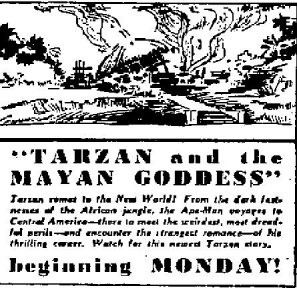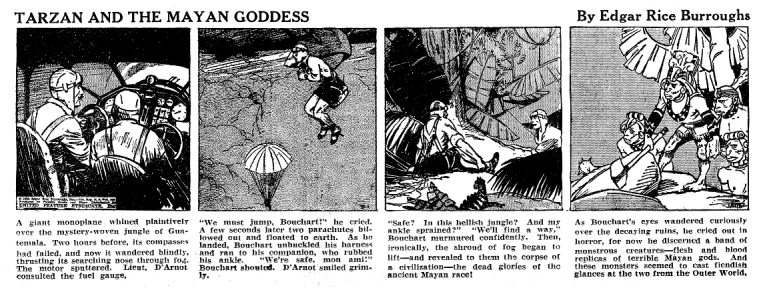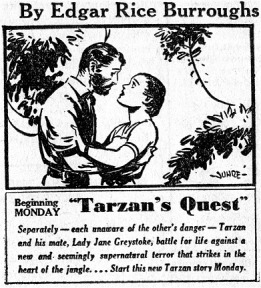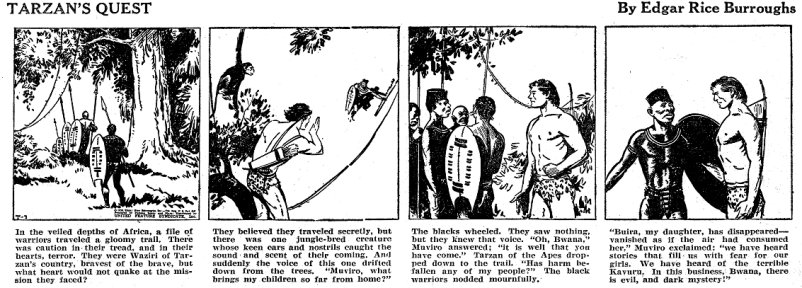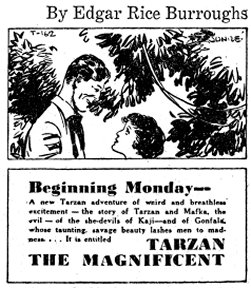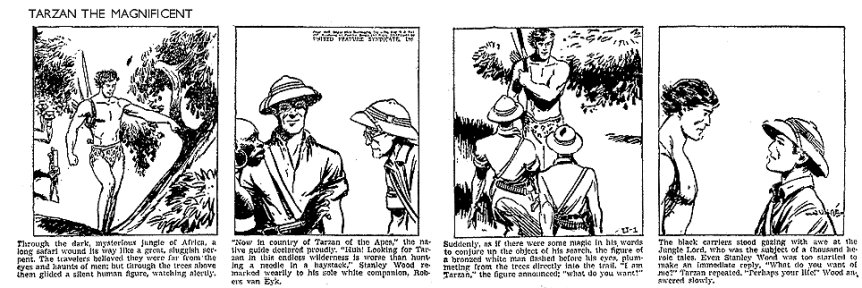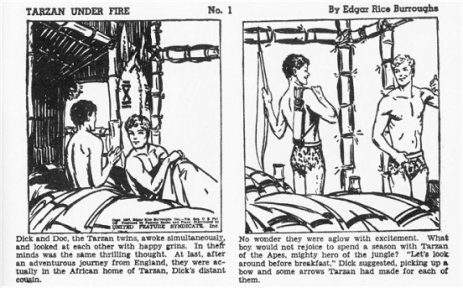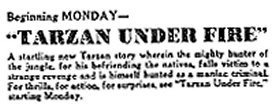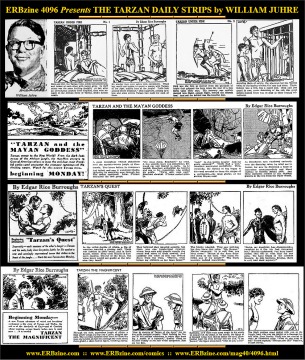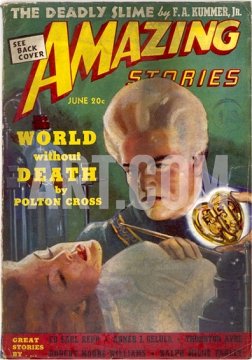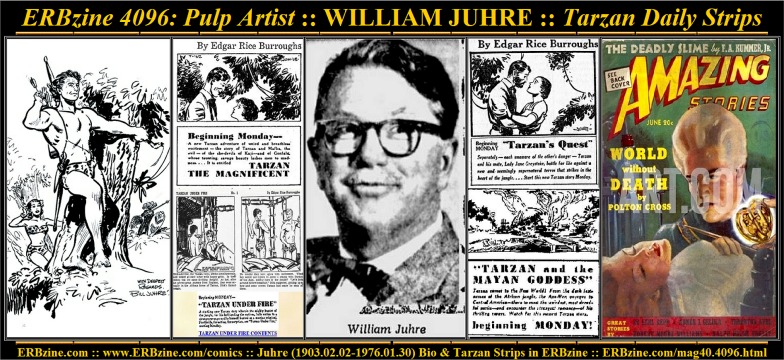
ERB was sent the synopsis for Tarzan and the Green
Goddess in March 1936. He wasn't totally satisfied with it. He noted
that it seemed "to have been taken from one of the original picture scenarios
from which the picture deviated materially."
He thought the scene of Tarzan uprooting a sapling and
defeating an army of Indians armed with machetes was implausible. Events
would be far more plausible if the omission of George's machine gun be
reinstated into the plot.
He also requested that snakes in the plot be removed since
he had observed "that snakes are highly objectionable to many people" and
in some theatres were even barred from the screen.
He thought the scene where Tarzan pacified the Indians
with a yo-yo to be somewhat silly and that "it fell terribly flat in the
original picture and was discarded. All the Indians had to do was take
the yo-yo away from them. It was not necessary to pay five canoes for it.
It would be better to have Tarzan fight his way clear. He might disarm
and capture the chief, using him as a hostage until the others were safely
out of the way. Then Tarzan and Nkima could take to the trees."
UFS was unsatisfied with the title Tarzan and the Green
Goddess from which the film story line was taken. They wanted the title
to suggest a Central American locale and sent Ed over 20 alternate titles.
Ed chose
Tarzan and the Jungle Goddess, but eventually, everyone
agreed on
Tarzan and the Mayan Goddess.
Ed previewed the first 12 continuities for Mayan
Goddess and made the following suggestions:
"Strip No. 1 shows a giant monoplane crashing into the
top of a tree in the fog, plunging to the earth, bursting into flame, and
the two men escaping uninjured except for one sprained ankle. Incidents
must be plausible. This is not. The two men lost in the fog, running out
of gas, should bail out. It would be just as effective and far more plausible.
"Strip No. 7. It is unwise to have Nkima talk too much.
If he must talk, use the fewest possible words. He did not call Tarzan
'master.' It would be helpful if the writer would familiarize himself with
the characters I have created and depict them accordingly. Tarzan should
not talk too much, and his speech should never be flowery -- in fact,
none of the dialogue should be in this style, which today borders upon
the archaic. This criticism not only applies generally to the manuscript
but especially in Strip No. 7 to Tarzan's speech to Muviro.
In strips 8 and 10, the impression is gained that the
party takes ship at Nairobi. Inasmuch as Nairobi is about three hundred
miles from the coast, this should be changed. They may take ship at Mombassa
which is connected by railroad with Nairobi.
In strip 9, there is another example of the type of writing,
however fine it may be, that I think we should try to avoid in the Tarzan
strips, which are supposed to be written by me and should be more or less
in my style."
Continuity writer Don Garden did the requested rewrite
as well as for strips 39 and 40 which Ed found to be rather boring.

Juhre and Garden's next series was Tarzan's Quest.
Meanwhile, for the Tarzan strip following Tarzan and the Mayan Goddess,
Ed had submitted the original script for Tarzan
the Magnificent which was published by Argosy (actually
this was only the first half of what would later be released in book form
as Tarzan the Magnificent -- the second half would be written
later as Tarzan and the Elephant Men.) William Lass sent Ed the
strip synopsis for this strip, but stressed that they would be making some
changes:
"In the original story, you will remember that the Amazonian
tribe was a negro tribe whose women were gradually making themselves white
by killing off their men and capturing white men for mates. We felt that
among newspaper readers, particularly in the south, this would strike at
deep-rooted prejudices and controversies which would cause a great deal
of trouble in the long run. For that reason, we thought it advisable to
transform the tribe into whites, with no reference to any negroid past.
Instead, they are descendants of ancient Portuguese explorers, and Mafka,
the witch doctor, is a living relic of the ancient alchemists. . . . Aside
from this the strip will stick closely to the original story."
Ed drew their attention to a gaff that a reader had reported
to him. One of the Magnificent panels depicted the bearded Englishman menacing
Tarzan with a wooden club and a knife which the text indicated was in the
man's right hand. Juhre's drawing however, showed the club in the man's
right hand.

As a follow-up to Tarzan the Magnificent, UFS went
to the manuscript for Tarzan and the Tarzan Twins With Jad-Bal-Ja, the
Golden Lion. They wanted to change the title and sent Ed 13 to choose
from. Ed chose
Tarzan Under Fire or Tarzan and the Kidnappers.
Since the Lindbergh kidnapping was still fresh in peoples' minds, UFS thought
Tarzan
Under Fire would be more acceptable to the nation's newspapers.
Don Garden was directed to make Tarzan more prominent in the story and
to add material about Opar.
After Tarzan the Magnificent and Tarzan Under
Fire ("Tarzan Twins") finished their run Ed had no more published Tarzan
stories that could be adapted to daily strips. Ed planned to take over
the writing of the daily material himself. But due to business and personal
pressures in the summer of 1937 Ed couldn't follow through on this plan.
Instead, they decided to adapt Tarzan the Fearless, a movie scenario
that Ed had sent them previously. Gardner made numerous changes to the
plot which prompted Ed to suggest a minor changes to their adaptation which
included:
"Page 2. Suggest that 'ladder' would be better than 'wooden
staircase,' First, the wooden staircase would hide so much of the idol
as to lessen its effectiveness, and, second, I think natives would build
a ladder rather than a staircase.
"Page 2. I suggest that Tarzan smoke the meat rather than
hang it in the sun, where it would become fly-blown.
"Page 5. Mary would lose readers' sympathy if she
deserted her father and finance. Jeff might tell her that they had already
escaped.
"Page 7. Shouldn't 'Tree-God' by 'Tree-Demon?'"

As Juhre's strips progressed a number of major papers
-- Chicago Daily News, Detroit News, Los Angeles Times, and more and more
-- dropped the series or relegated it to a lesser position on their comics
pages. In September 1937, Ed worried that much of the waning interest in
the Tarzan strips were due to Juhre's over-use of prominent "talking heads"
rather than action in the panels. In a letter to Carlin, Ed suggested that
those responsible for the strip might benefit from looking at Hal Foster's
first strip: Tarzan of the Apes. He stated: ". . . I have written
directions for the artist to accompany the daily strips that I am personally
preparing. I am quoting one paragraph that is apropos:
"Regardless of the text, a strip will flop without well-drawn
interesting
illustrations. Each picture should illustrate its caption. A series of
close-ups and semiclose-ups is extremely boring. Use close-ups only occasionally
and when there is no action.
"In the continuity I am writing, I am doubtless violating
many of your established precedents; but I believe that I am giving sufficient
action and suspense in each strip to fully warrant my handling of the subject,
and I am also trying to give the artist something to illustrate.
"I am doing this work myself because I recognize the importance
to both of us of the daily strip. It is not enough that the Sunday Page
be outstanding; the daily strip should be also."
Carlin contacted Neebe and relayed ERB's -- and his own
-- dissatisfaction with Juhre's work. "Juhre is no Foster nor is
he a Hogarth, but he could do a lot better job than he is doing.
At the conclusion of Tarzan Under Fire, William
Juhre was replaced by Rex Maxon who was brought back to draw the Tarzan
the Fearless series.

Refs:
The Man Who Created Tarzan by Irwin Porges
~ Brigham Young University Press, 1975.
Tarzan of the Funnies by Robert R. Barrett
~ Mad Kings - House of Greystoke Press, 2002
Remembering
William Juhre

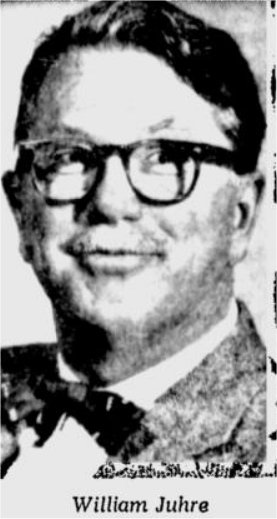 William
Juhre was born on February 2, 1903 in Williamsburg, near Milwaukee, Wisconsin.
His father died a year and a half later. Juhre was obsessed with art and
his sketches and caricatures made him very popular all through his school
years. America entered the Great War when he was 14, he and a buddy ran
off to join the army. Bill saw action with Pershing's Regulars in France
but around the time of his 15th birthday was hospitalized from a chlorine
gas attack. While in the hospital he contracted pneumonia and whiled away
many hours by drawing sketches of the medical staff.
William
Juhre was born on February 2, 1903 in Williamsburg, near Milwaukee, Wisconsin.
His father died a year and a half later. Juhre was obsessed with art and
his sketches and caricatures made him very popular all through his school
years. America entered the Great War when he was 14, he and a buddy ran
off to join the army. Bill saw action with Pershing's Regulars in France
but around the time of his 15th birthday was hospitalized from a chlorine
gas attack. While in the hospital he contracted pneumonia and whiled away
many hours by drawing sketches of the medical staff.
